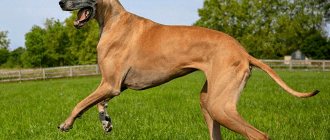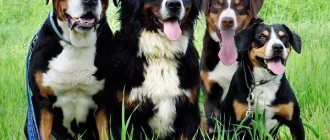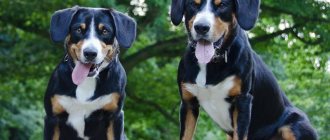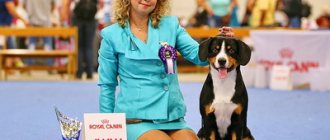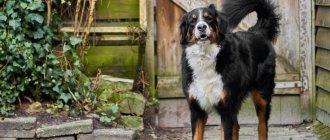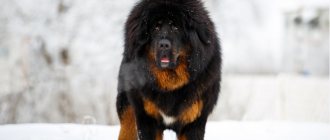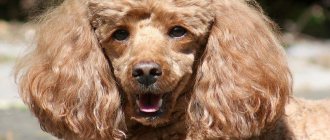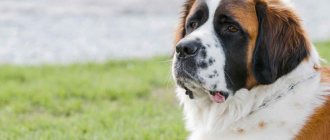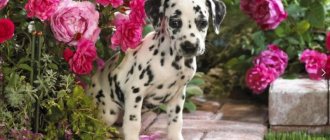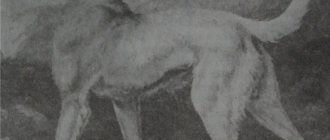The Greater Swiss Mountain Dog (GSZ) is also called a Grossie or Large Mountain Dog. This is a breed of noble, beautiful and strong animals, whose homeland is considered to be the Swiss Alps. The BSHZ is one of the four branches of modern Mountain Dogs, and it is recognized as the smallest. Read more about the characteristics of this breed and its care in our article.
Greater Swiss Mountain Dog: description of the breed
Story
The origins begin in the Alps. The officially accepted theory in the canine community states that the mountain breed was developed as a result of crossing local herding dogs and Tibetan mastiffs. However, others also participated in the formation of Sennenhoods. Traces of the presence of Central European Great Danes are clearly visible, and the “calling card” - the tri-color color in the exterior is taken from the Pinscher.
As you know, two factors are necessary for the appearance of a species - isolation and migration. The Swiss mountain valleys are mostly isolated, this provoked the emergence of a number of varieties of Sennenhunds, similar in color, but different in appearance and coat length. Over time, some species disappeared, but eventually 4 varieties became established: Entlebucher, Appenzeller, Bernese and Gross.
Interesting! Grosses were bred as watchmen, shepherds, guards, and were also used as traction force. Large size, impressive appearance and developed intelligence helped the dogs cope with the tasks set by people. After 1939, dogs were marketed primarily as family dogs and companions.
Most breeds until the 20th century were bred by trial and error and, of course, did not have a basis in the form of knowledge about selection, so we can only talk about the “legitimate” appearance of a standard starting from 1908. Professor Albert Heim showed the dogs to the world at an exhibition in Lagnenthal and proved their pedigree to be large mountain dogs. In 1908, the community recognized the grosses, and in 1939 the first standard was approved.
Description of the breed
Standard:
- Color : tricolor on a black background with red-brown tan markings, a white symmetrical pattern on the chest, in the middle of the muzzle there is also a white straight figure in the form of an inverted slingshot;
- Tail : straight, smoothly flowing from the dorsal line;
- Head : strong, more massive in males. No signs of “heaviness”;
- Eyes : medium, almond-shaped. Black edging, brown color. The look is kind;
- Muzzle : strong, width less than length;
- Nose : pigmented black;
- Ears : high, medium, triangular. Usually adjacent to the cheekbones, raised when interested;
- Neck : muscular, with a pronounced scruff;
- Bite : straight.
Important ! Unacceptable according to the standard: different color, eye color, lack of undercoat, timidity and shyness of character.
Dimensions:
- Height : males 65-72 cm, females 60-68 cm;
- Weight : males up to 60 kg, females up to 58 kg;
- Length relative to height at withers: 10:9;
Weight by month
| Months | 2 | 3 | 4 | 5 | 6 | 7 | 8 | 9 | 10 | 11 | 12 |
| Kg. (min.-max.) | 6-10 | 11-17 | 15-26 | 20-33 | 25-38 | 30-42 | 34-45 | 36-47 | 37-49 | 38-51 | 39-52 |
Howling and barking: loud, booming, when signaling danger.
With timely training, he does not allow himself to bark and howl in vain.
Where is the best place to buy a puppy?
You should approach the purchase of a puppy consciously and responsibly: decide on your own strengths and capabilities, take only from official or trusted nurseries, carefully examine it, and observe the behavior of the parents.
Among the reputable nurseries there are two known:
- in Voronezh "Pedigree Cynological Kennel of Swiss Mountain Dogs"
- in Moscow "Kingdom of Mountain Dogs".
Very important! Even despite the truism that we are responsible for those we have tamed, there are many discarded puppies on the street, both purebred and outbred. Therefore, before choosing, once again calculate your strengths and capabilities. Taking a living creature for fun is extremely cruel.
How to choose a puppy: important tips for a future dog owner. Everyone needs to know this!
How to choose a puppy
Greater Swiss Mountain Dog puppies are absolutely adorable. But not all of them are healthy and meet the breed standard.
In order not to buy a sick kitten with defects, first choose a nursery. Professional breeders value their reputation, so they:
- will calmly answer any, even stupid, questions;
- will show registration documents;
- will present pedigrees and veterinary passports of the producers;
- will demonstrate certificates of victories in competitions and documents allowing dogs for breeding.
It is better to choose a Greater Swiss Mountain Dog in person. At the meeting, the condition of the baby’s fur coat, eyes, ears, teeth and temperament are assessed. According to the photo, puppies are taken as a last resort - when they are imported from abroad.
Price
- Pet class babies will cost approximately 25-30 thousand rubles.
- A puppy of a higher class, “ breeding ”, will cost 35-45 thousand.
- show class exhibition puppies you will have to pay from 50 to 100 thousand rubles.
Today it is not so often possible to see the Greater Swiss Mountain Dog on the street. The rarity and impressiveness of representatives of this breed should not be the main reasons for purchasing a puppy. Such a pet will require a lot of time, patience and finances, so it is important to weigh your options.
Application
During World War II, the Swiss army actively used Gross dogs as draft animals. Indeed, they had all the makings for this.
Not only does the gross easily pass where the path is closed for a horse, but it also has good endurance and strength for dragging 10-kilogram loads over long distances.
It is worth noting that at that time the breed was not yet fully formed.
In such a harness, the big Swiss feels confident: he inherited this from his ancestors
The ancestor of the Greater Swiss Mountain Dogs is a dog named Barry von Herzogenbuchsee. Over the 10 years from 1912 to 1922, 11 dogs were entered into the pedigree book. The correct color from the point of view of this breed was developed after the war, in 1956.
During the fighting, the number of grosses was about a hundred individuals, and by the 50s this figure decreased again. Only thanks to the growing popularity of the breed in Germany, and then in other countries, today the number of representatives of the breed is very impressive.
Large Swiss Mountain Dogs are capable of competing in various dog sports and obedience. Thanks to their love of work, Grosses do an excellent job in the field of training.
Their strong spirit requires the same spirit from the trainer. However, there is a detail that makes them unsuitable for hunting and agility - their heavy weight and large dimensions.
Important! Grosses, like Alabais , do not tolerate harsh treatment: it can lead to the complete disappearance of positive traits in the dog’s character.
Owner reviews
Seryoga:
“Jack came to us when I was a teenager. He quickly became a friend to me, a listener to my youthful experiences. He was a real member of the family, and I was very sad when he passed away. By nature he is calm and patient, but when it was time to play while walking - how we frolicked! I remember this time with such warmth! Perhaps if it weren’t for him, I wouldn’t be who I am now.”
Annyta:
“A great guardian for the whole family. He’s been living with us for five years now and we dote on him. Strong, smartest dog. Not the slightest aggression towards guests or passers-by on the street. But one day some drunk tried to “run into” me, so Gray growled so much that he ran away apologizing and, it seems, sobered up. Loves kids. When I gave birth to my second, I could easily leave the older five-year-old with the dog during “quiet hour” and dozed off myself.”
Ivan:
“Cool breeds! We have both Bernese and Gross. We live in a private house and have no problems with them at all. They don’t compete with each other, although there are two boys. Cats also calmly walk around the territory, there is no aggression towards them. But when they knock on the gate, such a roar rises, it’s immediately clear that they are guarded conscientiously!”
VAsilisa:
“When I walk, I always feel drawn to. In general, this is their innate. But there are no problems with obedience. When I was younger, we simply taught him that when we go for a walk we get active, play and run a lot, but at home it’s quiet. And so it went. He doesn’t raise his voice without a reason, he knows all the commands perfectly, and he obeys. There is no aggression, but passers-by stand at attention when they see its size and power. We have never regretted having started it.”
Attitude towards animals and children
Well-mannered BSHZ get along well with children. They patiently endure the pranks of their little owners, and they themselves are extremely careful in games and communication, since they have an impressive size and weight.
BSHZ get along great with children
Grosses are tolerant of being around other animals. They do not show much interest in them, but they do not show aggression either. BSHZ gets along well with dogs of other breeds. Strained relationships are possible only between male dogs, but this is not a cost of the breed, but rather a fault of upbringing. In this case, the integrity and health of the smaller dog may be at risk. As for cats, a trained Mountain Dog will not touch them. Alternatively, the dog can be strict towards mustachioed animals that do not belong to the owner’s family.
Sennenhunds are tolerant of being around other animals.
The character and behavior of a dog largely depend on the upbringing of the animal, as well as on the owner’s ability to control his pet. The owner must be the undisputed leader for the gross, achieving this gradually and steadily. Otherwise, there will be problems with obedience. Animal psychologists do not consider Mountain Dogs to be a breed that strives for dominant behavior, so with the right approach, there is no need to fear a struggle for power in the family. However, grosses can stubbornly insist on their own, sometimes showing disobedience. Dog handlers recommend that owners of large breeds undergo a mandatory training course.
Character: pros and cons
Each animal is unique, but Grosses, who have been properly raised since childhood, can be vouched for in their endurance, balance of character and mental stability.
- This is a moderately active, but not fussy dog that is predictable in its actions. They are distinguished by high intelligence and quick wits, and are not prone to unmotivated aggression. They are person- and family-oriented and strongly attached.
- First of all, such dogs are excellent guards. A loud, bassy bark will completely repel the attempts of ill-wishers to enter the house. But for grosses, early socialization is extremely important, that is, communication with different people. The child must understand that the world consists not only of members of a particular family of owners who need to be protected. There are other quite friendly people who do not need to be afraid.
- Loneliness is tolerated very poorly; they can even get sick from melancholy.
- They get along well with children, they adore them and are wonderful nannies. They behave carefully and accurately. In addition, these dogs are instinctively built to protect the weak, so you don’t have to worry about children - Grosses never intentionally cause harm. But there are purely physical factors - due to the large size, the dog can accidentally step on or drop a small one, and the situation should still be controlled.
- Other animals are treated with tolerance, especially if they were raised in the same family. He can be perfect friends with the owner's cat, but on the street he growls and tries to chase other people's cats.
- One of the disadvantages is that without proper upbringing they can bark at everything around them and can show excessive stubbornness and waywardness of character. But this refers to the flaws of human omission; a well-mannered dog never allows himself to do this.
Important! Greater Swiss Mountain Dogs have a habit of jumping on their owner's chest for joy. It looks funny as a puppy, but an adult dog can inadvertently hurt a person. Such jumping should be gently stopped from childhood, replaced with other ways of expressing love and affection.
Conditions of detention
Large dogs need a lot of space and the ideal place to keep them would certainly be a private home with the possibility of free walking around the property.
Grosses are not designed to live on a chain or in a kennel. Even a spacious enclosure can only serve as a temporary shelter for this breed.
They live calmly in a city apartment, but with the condition of daily walking for at least 2-2.5 hours. The walk should consist of part of the training, which can include new commands, games, reinforcing the norms of behavior on the street and free walking, when the dog can simply frolic for his own pleasure.
Very important: this breed takes a very long time to mature, so toilet training outside will require time and effort. You don’t need to think that a dog is stupid because at 6 months they still relieve themselves on the floor - this is just their feature that needs to be understood. Be prepared for it or not take a puppy.
Health
Grosser cannot boast of longevity or a strong body. The breed suffers from hereditary and acquired diseases. And the average life expectancy is 8-10 years.
How long a pet will live depends on genes, quality of feeding and care. Owners whose Greater Swiss Mountain Dogs celebrated their 12th or 13th birthday are considered lucky.
Diseases
Greater Swiss Mountain Dogs are susceptible to:
- cancer;
- eye diseases (entropy, cataracts, atrophy);
- epilepsy;
- skeletal problems: osteochondrosis, dysplasia of the elbow and hip joints;
- enuresis - females are more likely to suffer.
To prevent dysplasia, avoid excessive stress, carrying heavy objects, and jumping from heights. Puppies up to 4-6 months of age are held in arms when going up and down stairs.
Vaccinations
Vaccination is required. Greater Swiss Mountain Dogs are vaccinated against:
- plague, trichophytosis, enteritis, hepatitis, leptospirosis, coronavirus - at 8 weeks followed by vaccination at 12 weeks;
- rabies – at 6 months;
- at 12 months and then annually receive a comprehensive vaccination against possible infections.
The exact vaccination schedule and list of vaccines are compiled by a veterinarian for each dog separately, taking into account the individual characteristics of the pet and the epidemiological situation in the area.
Necessary care
The basis for the health of a Greater Swiss Shepherd is a balanced, complete diet. Improper feeding causes joint injuries and brittle bones.
A small puppy needs to be provided with six divided meals a day . As they grow older, the frequency of feeding is reduced to half.
The basis of the diet is animal protein. But you definitely need to include and combine meat with the following products:
- Pre-cooked offal: kidneys, heart, ventricles, tongues;
- Porridge: buckwheat, oatmeal, corn, rice, etc. They can be boiled in broths, used as a base, adding pieces of meat, vegetables, herbs;
- Raw and boiled vegetables;
- Sour milk in moderate quantities: yogurt, fermented baked milk, kefir.
- Bone meal as a source of vitamins and minerals;
- Vitamin complex. For selection, you should contact your veterinarian.
- Many Gross people like cheese. Low-fat varieties in moderation are a great reward for them.
Interesting! Some dogs enjoy eating fruits and berries. You can pamper your pet with such a treat, but you should not give grapes.
What to feed your dog at home: natural food diet and weekly menu
It is strictly forbidden to give:
- Sweets;
- Baking;
- Tubular bones.
When feeding on industrial feed, the choice should be made on premium and super premium class. They are correctly balanced and already contain the necessary vitamin and mineral complex. Among such foods are Royal Canin, Hiils, Acana, Go, Grandorf.
Grooming procedures consist of a standard approach:
- Grooming: Once a week, brush with a stiff brush. When shedding , brush more often. They shed twice a year. Particular attention should be paid to the neck and chest area, as hair loss there is more intense;
- Wiping the eyes and ears: daily inspection for the absence of suppuration and parasites, wiping with a cotton pad soaked in chamomile infusion or boiled warm water;
- Nail trimming: usually not required; an active dog will trim them down while running;
- Washing and examining paws : daily after a walk;
- Full bathing: only in emergencies. Simply wiping your paws every day is enough.
Diet: how to choose the right menu
A Grosser dog can be fed in two ways:
- natural food. In this case, the basis is meat and offal (60% of the daily requirement). 20% comes from vegetables and fruits and the remaining 20% from fermented milk products and cereals;
- ready food This option is very convenient for owners. The main diet should be high quality food (Brit Care, Acana, Happy Dog, etc.).
Important! With a natural diet, the animal must receive vitamin and mineral supplements. They are given to the pet in courses for 30 days twice a year.
Training and education
These dogs strive to please, so they are attentive to human actions and are easy to train. Natural intelligence and intelligence only contribute to the acquisition of skills. Since their ancestors were mountain shepherd dogs and were used as draft dogs, they calmly tolerate the monotony and monotony of actions.
But, of course, without a person they will not be able to educate themselves. A competent, systematic approach to training, constant control and firmness on the part of the person is the key to success.
Here are five tips to help when training Grossies:
- You need to immediately show the dog that the leader is a man and he is in charge;
- Show consistency and discipline, otherwise the grosses will immediately stop respecting and accepting the soft and “lisping” owners;
- Screaming, beating and rudeness are prohibited. The dog will either run away or get angry;
- Give commands clearly and clearly. Dogs learn words with two syllables better. After completion, encouragement is required;
- Sennenhunds take a long time to mature, so more time needs to be spent on strengthening.
The main responsibility for raising an animal lies with the individual. The extent to which commands are understood and assimilated depends on the owner.
Important! This phenomenon is not uncommon in everyday life: when getting a dog, adults shift the responsibility for walking and training to children. Doing this is strictly prohibited! At least with puppies. A priori, a younger family member cannot become an authority in the dog’s eyes.
If the breeder understands that he does not have the necessary endurance and leadership qualities, then he needs to either think about the advisability of purchasing such a dog for his home, or entrust the upbringing to specially trained people - professional dog handlers.
Key points in training
Greater Swiss Mountain Dogs are very intelligent, they respond well to training and quickly learn commands, especially when performing monotonous tasks. By raising and socializing your dog from an early age, you can make it obedient and friendly.
Training will only be effective if the owner makes the dog understand his position as a leader. Otherwise, the dog simply will not obey, and you need to contact a professional dog handler to correct its behavior.
When training, you should not raise your voice at your pet or cause physical pain to it. The owner is required to have self-confidence, composure and concentration, and maintain contact with the dog. Commands must be clear and understandable; after they are completed, the dog receives praise.
Read about how to properly train a dog in the article: “Training a puppy: effective methods from dog handlers, learning commands at home.”
The Mountain Dog may become stubborn and refuse to follow a command, in which case it is worth showing patience and perseverance. When keeping a large Swiss Mountain Dog in an apartment, you will have to pay great attention to weaning it from barking indoors.
Nicknames for boys and girls
The selection of nicknames is an individual decision for everyone. In reality, nicknames are given based on personal preferences. But, if a person wants to give a noble name to his faithful friend, you can use one of those proposed in the list.
It is better to give names to dogs short and clear. They should not consist of a large number of syllables, optimally two syllables.
- For boys: Bern, Jack, Bruce, Don, Duck, Peter, West, Nord, Alp, Gut, Prime, Tuk, Zeus, Hera, Cruz, Rome, Gray.
- for girls : Gina, Zara, Kira, Lara, G, Day, Knight, Eva, Uma, Polly, Mira, Utah, Shani, Mona, Daisy, Vika, Vita, Laura.
Who is better: Bernese or Grosser?
Although Berns and Gross are essentially brothers, there are significant differences between them:
- The difference is in temperament and character: from the experience of breeders, we can say that Bernese Mountain Dogs are more phlegmatic, while Gross Dogs are sanguine, they are emotional and lively, but not malicious.
- They also show their love in different ways : Berns are restrained in their feelings, calm, reasonable and serious, while Grosses are sincere and emotionally responsive;
- Heat resistance . Long-haired Bernese dogs suffer from the heat in the apartment in the summer, while smooth-haired dogs are comfortable at any time of the year;
Whom to choose is up to the breeder. Any pet will require time, effort and financial investment. It is important to understand that the acquisition of a living creature is permanent, not temporary, and when the first difficulties arise, you should not throw it out into the street.
Three interesting facts
- They fiercely and relentlessly protect the weak half of humanity . If the breeder turns out to be a woman, then men should be more careful when approaching a lady with such a dog on the street. Since ancient times, the Grosses have protected the family and especially its weaker members, women and children. This habit became firmly established and became a character trait.
- Can't stand perfume . Very often this breed is allergic to strong odors.
- They feel calm in harness . They can be harnessed together with ponies, for example. And all because for a long time grosses were used as draft animals.
Advantages and disadvantages
When purchasing a Mountain Dog, you should take into account the characteristics of this breed. There are nuances in their content, as they have their pros and cons:
| Advantages | Flaws |
| The Sennenhund has excellent guard qualities. Dog breeders claim that they practically do not sleep, feeling every rustle. | Large dimensions make it almost impossible for dogs to live in apartments. Also, you can’t keep her in an enclosure all the time. |
| Dogs of this breed are excellent nannies for children. They love children and jealously protect “two-legged puppies” from any danger. | During the shedding season, a lot of hair falls out. |
| Sennenhunds are clean dogs; unlike other large dogs, they do not drool from their mouths. | They do not tolerate heat well. |
| They easily learn commands and rules of behavior. | They cannot stand loneliness. |
Photo
Serious pie!
Video
Extremely educational show:
In conclusion, I would like to note once again that the Greater Swiss Mountain Dog is an incredibly open, kind and strong dog, indispensable for protecting the family. The facts and advice given in the article may have deepened knowledge about the breed, forced some to rethink the decision, and, on the contrary, strengthened others. Well, the happy owners of the grosses probably learned something new. Let's discuss the material in the comments and share our experience and photos of our beauties here.
Behavior and temperament
Swiss Mountain Dogs rightfully bear the title of one of the most harmonious breeds in character. They are calm, intelligent, self-confident and very social. The Swiss does not choose one owner for himself, he becomes attached to the whole family and takes care of it as his own flock.
Positive sides:
- friendliness;
- loyalty;
- curiosity;
- excellent learning ability;
- calm, balanced temperament;
- courage.
Negative features:
- stubbornness, willfulness;
- difficulty in establishing contact with strangers.
